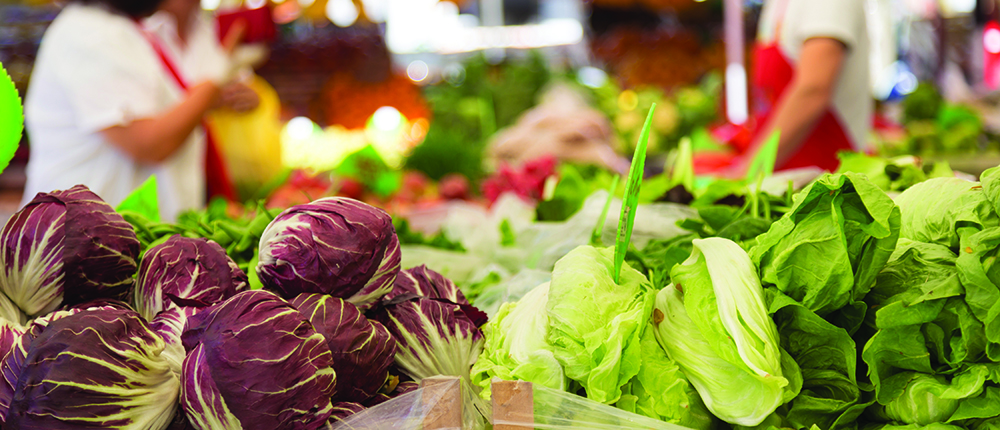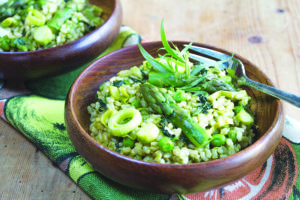
Victoria Beechum
Spring is just around the corner, and with it comes the promise of plenty of in-season, locally grown produce. Crisp lettuce and kale, frilly heads of cabbage, radishes and onions to tingle the tongue… Fresh and local fare is more nutritious and often cheaper, too. Why not head out and hand-pick your own produce at one of Winnipeg’s many conveniently located farmers’ markets?
Variety: the spice of life
Planning your meals around the calendar by using in-season produce can be fun, and a great way to force you out of a recipe rut. Many us of have a habit of loading our grocery carts or baskets with the same items week after week. Eating with the seasons imposes variety on your diet and keeps your routine from going stale. Eating a variety of fresh fruits and vegetables is also good for your health and can widen the nutritional profile of your diet.
“Shipping produce across the world is very expensive and time-consuming,” says Amy Campbell, a clinical dietitian at Deer Lodge Centre. “The result is often poor quality and less-than-tasty produce. Local produce spends less time travelling, sitting in storage, and waiting on a shelf to be bought. The sooner you can eat your produce after it has been picked or harvested, the more nutritious it will be.”
Fresh makes economic sense
While you’re balancing your diet, why not balance your budget? Buying produce that is in season in your region is often cheaper than buying it at other times of the year. And when you buy local, you keep your money in your community.
Shopping local can add up to big savings. Check out our list below for some of the produce that will be in season over the coming months.
“You’ll notice that there is bit of a white theme to the in-season spring produce on the list,” observes Campbell, “but also leafy greens and orange options. That’s because the Canada Food Guide recommends a dark green leafy and/or orange vegetable per day.”
To market, to market
Farmers’ markets are the best go-to source for locally-grown produce. These markets can also be a fun way to spend an afternoon and turn a mundane chore into a pleasurable activity.
If you enjoy your current shopping routine, you can also find local options in conventional grocery stores. Steer your cart towards items you know are in season in Canada. Before you toss something in your cart, take a moment to check the label to see where it’s from.
Late winter and early spring tricks
Eating only the limited range of in-season, locally-grown produce available in Manitoba during the winter and early spring can start to feel restrictive and boring. Planting a few herbs in a sunny window will liven up your meals.
“What better way to brighten your day than to start some fresh herbs on your window sill,” suggests Campbell. “You can start them from seed, and they don’t take a lot of tending to. Just find a sunny spot and let them grow. They’re so great to add to your dishes when the spring produce comes out.”
Buying frozen berries is also a great way to supplement your diet: they taste great, come in a variety of colours, and pack a nutritional punch. And, of course, you can find options harvested in Manitoba and Canada.
Our Spring recipe highlights leeks, kale and asparagus, all of which are in season at the same time. All three contain beta-carotene and vitamin A (which is great for eye health). Asparagus is a natural source of folate, which is good for red blood cell formation and important during the early stage of pregnancy. These vegetables are naturally low in sodium and high in potassium, which means they can also have beneficial effects on blood pressure.
In-season produce for the Western provinces
Spring
- Rhubarb
- Asparagus
- Cabbage
- Carrots
- Kale
- Leeks
- Mushrooms
- Onions (Red & Yellow) Parsnips
- Radishes Sweet Potatoes
Early Summer
Same as spring, plus:
- Cherries
- Gooseberries Strawberries Asian Greens Bok Choy
- Broccoli
- Chard, Swiss
- Lettuce (Field)
- Onions (Green)
- Peas (Green & Snow)
- Spinach
- Squash
- Turnips
List adapted from:
Find a farmers’ market near you
- Bronx Park Community
Centre 720 Henderson Hwy
- Downtown Winnipeg Biz
MB Hydro Plaza, 360 Portage Ave
- East St. Paul
302 Hoddinott Rd, East St. Paul
- FortWhyte Farms
FortWhyte Alive (in the farm buildings with the tin roof)
- Good Food Club Mini Market
185 Young Street, in gymnasium
- Health Sciences Centre
707 McDermott Ave (small surface parking lot between HSC and the university)
- Main Street
Call (204) 927-2342 for location
- Pop Up Farmers’ Market
Several downtown locations to choose from, call (204) 293-7566 for details
- Provencher Biz
Corner of Provencher Blvd and Langevin St
- Red River
Red River Exhibition Park
- River Heights
Corydon Community Centre, Oak St and Grosvenor Ave
- St. Norbert
3514 Pembina Hwy
- Shelmerdine Garden Centre
7800 Roblin Blvd
- South Osbourne
725 Kylemore Ave
- Transcona Biz Market Garden
135 Regent Ave West
- Wellness institute
1075 Leila Ave (front entrance)
- West Broadway
185 Young St (outdoor hockey rink)
- Wolseley
Robert A. Steen Community Centre behind Laura Secord School
For more information:
- www.gov.mb.ca/agriculture/local-food/pubs/produce-guide.pdf
- csamanitoba.org/find/
- www.directfarmmanitoba.ca/csa/shares
 Recipe:
Recipe:
Spring leek, kale and asparagus risotto
Amy Campbell
Ingredients
Serves 4 to 6
- 2 tbsp extra-virgin olive oil, divided
- 1 large leek, cut thinly in circles (about 1½ cups)
- 8 asparagus spears, trimmed, and sliced (about 2 cups)
- 6 kale leaves, cleaned and sliced thinly (about 1 cup)
- 1 tbsp fresh tarragon, chopped fine (can use fresh basil, too)
- ½ cup green peas, fresh or frozen
- 6 cups vegetable broth
- 2 tbsp unsalted butter, divided
- 2 green onion, cleaned, sliced thinly
- 1 tbsp fresh garlic, peeled and minced 2 cups Arborio rice
- ⅓ cup dry white wine
- ⅓ cup Parmigiano-Reggiano cheese, shaved
Preparation
- Rinse the leeks with plenty of cold water to remove dirt, and pat dry.
- For the veggies: In a heavy-bottomed pot, add 1 tbsp olive oil, and place over medium heat.
- Add the asparagus, kale, leeks, and tarragon. Sauté for 3 minutes until vegetables are crisp-tender. Add the peas (fresh or frozen), stir to combine—no need to cook them. Remove the vegetables to a bowl.
- For the risotto: Place vegetable broth in a pot to hold, bring to a bare simmer while you start the risotto.
- Add 1 tbsp butter and 1 tbsp olive oil to a large, heavy bottomed pot. Add the scallions, garlic, and rice; cook for 2 minutes over medium heat. Add the wine; stir until it has evaporated.
- Add 1 cup of hot broth to the pot; stir until it’s all been absorbed, about 5 minutes. Add the remaining broth, ½ cup at a time, waiting until almost all the liquid has been absorbed before adding more broth. Stir frequently. It will take about 25 minutes for all the broth to be absorbed. You want the rice at the end to be creamy and tender.
- Add the sautéed vegetables and 1 tbsp cold butter. Give a big stir, and warm through over low heat until creamy—just 1 minute. Remove from heat, stir in Parmigiano-Reggiano cheese, and pepper to taste.
Amy Campbell is a Clinical Dietician for Deer Lodge Centre.
Recent News

Embracing Hope: The Impact of DLC’s Movement Disorder Clinic

Winnipeg Jets Parkinson’s Disease Awareness Game!

